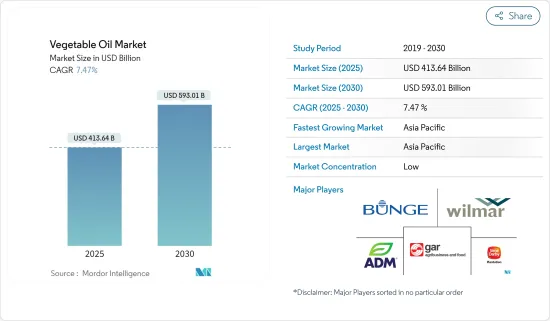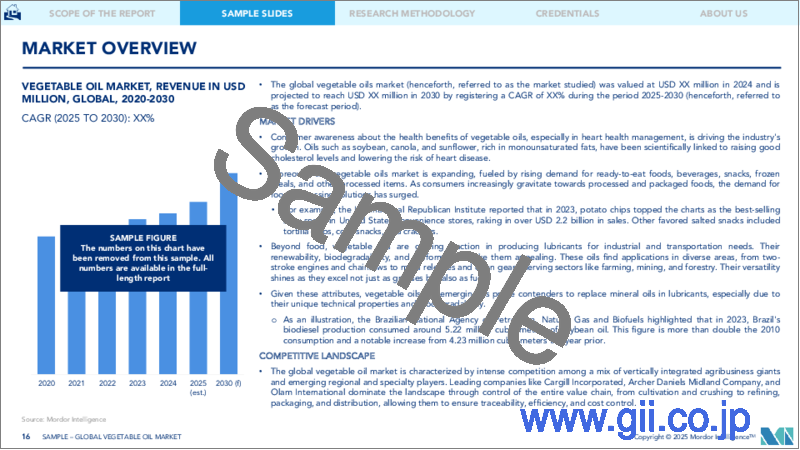|
|
市場調査レポート
商品コード
1685734
植物油:市場シェア分析、産業動向・統計、成長予測(2025年~2030年)Vegetable Oil - Market Share Analysis, Industry Trends & Statistics, Growth Forecasts (2025 - 2030) |
||||||
カスタマイズ可能
適宜更新あり
|
|||||||
| 植物油:市場シェア分析、産業動向・統計、成長予測(2025年~2030年) |
|
出版日: 2025年03月18日
発行: Mordor Intelligence
ページ情報: 英文 140 Pages
納期: 2~3営業日
|
- 全表示
- 概要
- 目次
植物油市場規模は2025年に4,136億4,000万米ドルと推定され、予測期間中(2025-2030年)のCAGRは7.47%で、2030年には5,930億1,000万米ドルに達すると予測されます。

ロシアとウクライナの戦争により、植物油の価格は史上最高値まで上昇しています。黒海諸国はヒマワリ油の重要な輸出国です。従って、この戦争問題は植物油価格の高騰を引き起こし、さらに供給を制限し経費を押し上げる貿易政策上の反応を世界的に促しています。国際食料政策研究所によると、侵攻当日から40%上昇し、ヒマワリ油が最も直接的な影響を受けている、
短期的には、心臓の健康をコントロールするなど、植物油を摂取することの健康上の利点に対する人々の意識の高まりが業界を牽引すると予想されます。オリーブ油、キャノーラ油、ひまわり油、ヘーゼルナッツ油、アーモンド油などの食品に含まれる一価不飽和脂肪は、善玉コレステロール値を上げ、心臓や心血管障害のリスクを最小限に抑えることが証明されています。植物油は、燃料、食器洗い機、香水用組成物を作るため、現在高い需要があります。これが市場拡大の主な原動力の一つとなっています。例えば、USDA Foreign Agricultural Serviceによると、2021年にインドでバイオディーゼル燃料生産の原料として使用される使用済み食用油の量は5万5,000トンで、2020年の5万トンから増加しています。
さらに、さまざまな最終用途産業において、鉱物油の代替として植物油のニーズが大幅に高まっています。植物性絶縁油は現在、変圧器用途で鉱物性油に代わるものとして市販されています。植物油は、安価で揮発性が低く、圧力下での性能が向上し、粘度が高く、広く入手可能であるため、鉱物油の完璧な代替品となり得る。業界をリードする競合各社は現在、ほとんど加工処理されておらず、有機的な植物油の品種を提供しています。これは、植物油のようなバイオベースの商品を促進するために、様々な国の統治機関が開始した数多くのプログラムと相まって、市場の拡大を促しています。
植物油市場の動向
強化植物油の需要増加
強化植物油の主な原動力は、あらゆる人口集団の健康と生産性に悪影響を及ぼし、深刻な公衆衛生問題を引き起こす多数の微量栄養素の欠乏です。さらに、多くの妊産婦とその新生児はビタミンD欠乏症です。食用油のビタミンAとビタミンDの強化は、技術的にも経済的にも実現可能な技術であることが証明されています。FSSAIによれば、食用油を強化することで、必要量よりも25%から30%多くビタミンDとビタミンAを摂取することができるといいます。消費者の意識の高まりを受けて、いくつかの国では主食、特に油の強化促進のための大規模な取り組みを開始しています。各国政府も、食品強化の重要性と、国際的な栄養目標の達成を支援する可能性を認めています。例えば、インド食品安全基準局(FSSAI)は2021年に、免疫力を強化し、栄養不良、特に微量栄養素の不足と闘うために、食用油/食用油のビタミンAおよびビタミンDの義務強化を求める提言を発表しました。
大手企業も植物油の強化に向けて必要な取り組みを行っています。例えば、2021年9月、生産量に関係なく食用油を強化するため、BASF西アフリカはEDCEL Limitedと提携し、食用油用ビタミンAプレミックスを発売しました。同社は、このような取り組みにより、中小規模(MSMEs)企業傘下の製粉業者が手頃な価格のビタミンAパックを入手できるようになると主張しています。
アジア太平洋が植物油市場を独占
アジア太平洋は世界の植物油市場の支配的な地域であり、アジア太平洋では中国が植物油の消費と生産で最大のシェアを占めています。生産量は多いもの、消費量が生産量を上回っているため、輸出量に比べて輸入量が多くなっています。例えば米国農務省によると、2021年に中国の人口が消費したヒマワリ種子油は約260万トンで、前年の約207万トンから増加しています。
中国の植物油市場は、主にパーム油、大豆油、菜種油、落花生油、ひまわり油、オリーブ油で構成されています。過去5年間、中国の植物油市場では大豆とパーム油が最大のシェアを占めていました。Wilmar International Ltd(Yihai Kerry)、Cofco Corporation、Xiwang Foodは、中国およびアジア市場で事業を展開する大手食用植物油企業です。日本もまた、この業界の主要企業です。日本はほとんどのオリーブ油を南欧から輸入しており、調理用や非食品用に使用されています。米国農務省によると、日本におけるオリーブ油の消費量は、2020年の6万9,000トンから2021年には約7万5,000トンに増加します。同様に、インドも食用油の自立に向けた機敏な対策を講じています。2021年8月、政府は国内油糧種子生産を増加させ、食用油の自給を達成するため、国家食用油ミッション-オイルパーム(NMEO-OP)を宣言しました。植物油の生産量を増やすために、改良された種子や技術などあらゆる利点を農家に与えるため、政府は油糧種子・油糧パーム国家ミッションを通じて11,000クロー以上を投資すると表明しました。このような取り組みにより、予測期間中、同地域の生産性、消費、売上が増加すると予想されます。
植物油業界の概要
植物油市場は競争が激しく、調査対象市場の主要企業が採用している実践的戦略には、製品革新、提携、事業拡大、M&Aなどが含まれます。Sime Darby Plantation Berhad、Wilmar International Limited、Bunge Limited、Golden Agri-Resources、Archer Daniels Midland Companyなどが、調査対象市場における著名なプレーヤーです。同市場の主要企業は、多くの消費者の需要に応えるため、幅広い地域的プレゼンスと広範な製品ポートフォリオを有しています。この要素は、企業が市場で確固たる足場を維持するのに役立っています。
その他の特典:
- エクセル形式の市場予測(ME)シート
- 3ヶ月間のアナリスト・サポート
目次
第1章 イントロダクション
- 調査の前提条件と市場定義
- 調査範囲
第2章 調査手法
第3章 エグゼクティブサマリー
第4章 市場力学
- 市場促進要因
- 市場抑制要因
- ポーターのファイブフォース分析
- 新規参入業者の脅威
- 買い手・消費者の交渉力
- 供給企業の交渉力
- 代替品の脅威
- 競争企業間の敵対関係の強さ
第5章 市場セグメンテーション
- タイプ別
- パーム油
- 大豆油
- 菜種油
- ひまわり油
- オリーブ油
- その他
- 用途別
- 食品
- 飼料
- 工業
- 地域別
- 北米
- 米国
- カナダ
- メキシコ
- その他北米地域
- 欧州
- 英国
- ドイツ
- スペイン
- フランス
- イタリア
- ロシア
- その他欧州
- アジア太平洋
- 中国
- 日本
- インド
- オーストラリア
- その他アジア太平洋地域
- 南米
- ブラジル
- アルゼンチン
- その他南米
- 中東・アフリカ
- アラブ首長国連邦
- 南アフリカ
- その他中東とアフリカ
- 北米
第6章 競合情勢
- 市場シェア分析
- 最も採用されている戦略
- 企業プロファイル
- Archer Daniels Midland Company
- Sime Darby Plantation Berhad
- Bunge Limited
- Olam International Limited
- Cargill Incorporated
- Golden Agri-Resources
- Kuala Lumpur Kepong Berhad
- Fuji Oil Holding Inc.
- Wilmar International Limited
- PT Astra Agro Lestari Tbk
第7章 市場機会と今後の動向
The Vegetable Oil Market size is estimated at USD 413.64 billion in 2025, and is expected to reach USD 593.01 billion by 2030, at a CAGR of 7.47% during the forecast period (2025-2030).

Russia and Ukraine's war has pushed the prices of vegetable oils to an all-time high. The Black Sea countries are significant exporters of sunflower oil. Thus, this war problem has caused vegetable oil prices to rise sharply and has also prompted trade policy reactions globally that further restricted supplies and drive-up expenses. According to the international food policy research institute, with a 40% increase since the day of the invasion, sunflower oil has been most immediately impacted,
Over the short term, the industry is expected to be driven by people's growing awareness of the health benefits of consuming vegetable oils, such as controlling heart health. The monounsaturated fats in foods like olive oil, canola oil, sunflower oil, hazelnut oil, and almond oil are proven to raise good cholesterol levels and minimize the risk of heart and cardiovascular disorders. Vegetable oils are currently in high demand since they create fuels, dishwashers, and perfume compositions. This is one of the main driving forces for the market's expansion. For instance, according to USDA Foreign Agricultural Service, the volume of used cooking oil used as a feedstock for biodiesel fuel production in India in 2021 was 55,000 metric tons, increasing from 50,000 metric tons in 2020.
In addition, there is a significant rise in the need for vegetable oils as an alternative to mineral oil across different end-use industries. Vegetable isolating oils are now commercially available to replace mineral-based oils in transformer applications. Vegetable oil may be a perfect replacement for mineral oil because of its inexpensive cost, reduced volatility, improved performance under pressure, high viscosity, and widespread accessibility. Leading industry competitors are now offering vegetable oil varieties that have undergone little processing and are organic. This is encouraging the market's expansion, coupled with numerous programs launched by governing bodies of various nations to promote bio-based goods like vegetable oils.
Vegetable Oil Market Trends
Increasing Demand For Fortified Vegetable Oils
The main driving force behind enriched vegetable oils is a multitude of micronutrient deficiencies that negatively influence the health and productivity of all demographic groups and result in serious public health issues. Additionally, many expectant mothers and their newborns are vitamin D deficient. Cooking oil fortification with vitamins A and D is a proven technically and economically feasible technique. According to the FSSAI, Fortifying cooking oil can aid people in consuming 25% to 30% more vitamin D and A than is required. Several nations have started large-scale initiatives to promote the fortification of staple foods, especially oils, in response to rising consumer awareness. Governments also acknowledge the importance of food fortification and its potential to support the achievement of international nutrition targets. For example, the Food Safety and Standards Authority of India (FSSAI) published a proposal in 2021 calling for the mandatory fortification of cooking/edible oil with vitamins A and D to strengthen immunity and combat malnutrition, particularly deficits in micronutrients.
Major players are also taking necessary initiatives toward the fortification of vegetable oils. For instance, in September 2021, to fortify edible oils, regardless of the quantity being produced, BASF West Africa teamed up with EDCEL Limited and launched the Vitamin A premix for edible oils. The company claimed that such initiatives would provide millers operating under the Small and Medium Scale (MSMEs) enterprise access to an affordable pack size of Vitamin A. Such actions and the rising demand for fortified vegetable oils are expected to drive sales.
Asia-Pacific Dominates the Vegetable Oil Market
Asia-Pacific is the dominant region for the vegetable oil market across the world, and in Asia-Pacific, China holds the largest share of vegetable oil consumption and production. Though the production volume is high, consumption exceeds production, resulting in higher import volumes when compared to export volumes. For instance, according to the US Department of Agriculture, in 2021, China's population consumed around 2.6 million metric tons of sunflower seed oil, an increase from approximately 2.07 million tons in the previous year.
The Chinese vegetable oil market majorly encompasses palm, soybean, rapeseed, peanut, sunflower, and olive oil. Over the past five years, soybean and palm oil had the largest shares in the Chinese vegetable oil market. Wilmar International Ltd (Yihai Kerry), Cofco Corporation, and Xiwang Food are some of the major edible vegetable oil companies operating in the Chinese and Asian markets. Japan is another major player in the industry. Japan imports most olive oil from Southern Europe, which is used for cooking and non-food uses. According to the US Department of Agriculture, the consumption volume of olive oil in Japan amounted to around 75 thousand metric tons in 2021 an increase from 69 thousand metric tons in 2020. Similarly, India is also taking agile measures to be self-reliant in edible oil. In August 2021, a National Edible Oil Mission-Oil Palm (NMEO-OP) was declared by the government to increase domestic oilseed production and achieve national self-sufficiency in cooking oils. In order to give farmers every advantage, including improved seeds and technology to increase its production of vegetable oil, the government asserted that it would invest more than 11,000 crores through the National Mission on Oilseeds and Oil Palm. Such initiatives are expected to boost productivity, consumption, and sales in the region during the forecast period.
Vegetable Oil Industry Overview
The vegetable oil market is competitive, and the practical strategies adopted by the key players in the market studied include product innovations, partnerships, expansions, and mergers and acquisitions. Sime Darby Plantation Berhad, Wilmar International Limited, Bunge Limited, Golden Agri-Resources, and Archer Daniels Midland Company are some prominent players in the market studied. The major players in the market have a broad geographical presence and extensive product portfolios to cater to numerous consumer demands. This factor assists the companies in maintaining a solid foothold in the market.
Additional Benefits:
- The market estimate (ME) sheet in Excel format
- 3 months of analyst support
TABLE OF CONTENTS
1 INTRODUCTION
- 1.1 Study Assumptions and Market Definition
- 1.2 Scope of the Study
2 RESEARCH METHODOLOGY
3 EXECUTIVE SUMMARY
4 MARKET DYNAMICS
- 4.1 Market Drivers
- 4.2 Market Restraints
- 4.3 Porter's Five Forces Analysis
- 4.3.1 Threat of New Entrants
- 4.3.2 Bargaining Power of Buyers/Consumers
- 4.3.3 Bargaining Power of Suppliers
- 4.3.4 Threat of Substitute Products
- 4.3.5 Intensity of Competitive Rivalry
5 MARKET SEGMENTATION
- 5.1 By Type
- 5.1.1 Palm Oil
- 5.1.2 Soybean Oil
- 5.1.3 Rapeseed Oil
- 5.1.4 Sunflower Oil
- 5.1.5 Olive Oil
- 5.1.6 Other Types
- 5.2 By Application
- 5.2.1 Food
- 5.2.2 Feed
- 5.2.3 Industrial
- 5.3 Geography
- 5.3.1 North America
- 5.3.1.1 United States
- 5.3.1.2 Canada
- 5.3.1.3 Mexico
- 5.3.1.4 Rest of North America
- 5.3.2 Europe
- 5.3.2.1 United Kingdom
- 5.3.2.2 Germany
- 5.3.2.3 Spain
- 5.3.2.4 France
- 5.3.2.5 Italy
- 5.3.2.6 Russia
- 5.3.2.7 Rest of Europe
- 5.3.3 Asia-Pacific
- 5.3.3.1 China
- 5.3.3.2 Japan
- 5.3.3.3 India
- 5.3.3.4 Australia
- 5.3.3.5 Rest of Asia-Pacific
- 5.3.4 South America
- 5.3.4.1 Brazil
- 5.3.4.2 Argentina
- 5.3.4.3 Rest of South America
- 5.3.5 Middle East & Africa
- 5.3.5.1 United Arab Emirates
- 5.3.5.2 South Africa
- 5.3.5.3 Rest of Middle East & Africa
- 5.3.1 North America
6 COMPETITIVE LANDSCAPE
- 6.1 Market Share Analysis
- 6.2 Most Adopted Strategies
- 6.3 Company Profiles
- 6.3.1 Archer Daniels Midland Company
- 6.3.2 Sime Darby Plantation Berhad
- 6.3.3 Bunge Limited
- 6.3.4 Olam International Limited
- 6.3.5 Cargill Incorporated
- 6.3.6 Golden Agri-Resources
- 6.3.7 Kuala Lumpur Kepong Berhad
- 6.3.8 Fuji Oil Holding Inc.
- 6.3.9 Wilmar International Limited
- 6.3.10 PT Astra Agro Lestari Tbk






